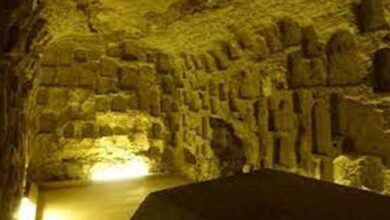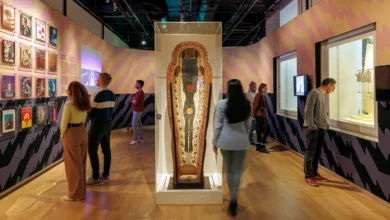
The hyena “dubba” is a striped hyena that is still present in some parts of Egypt, but the population is believed to be continuously declining. It is listed as near threatened by the International Union for the Conservation of Nature (IUCN), and its global population is estimated at 10,000 mature individuals scattered in sub-Saharan Africa, the Middle East, India and southwest Asia. The striped hyena was formerly found along the margins of the Nile Delta and Nile Valley and commonly entered towns searching for food.
The striped hyena’s most remarkable feature is its odd body shape, with headquarters far more developed than its hindquarters. Its head is massive, and its jaws are powerful and armed with large teeth to crush bones. The back is sloped, the bust short and the fur shaggy and striped. Hyenas have a peculiar, clumsy way of running when on level ground, with a slow and laboring canter.
The striped hyena is mostly a scavenger that will feed on ungulate carcasses and on eggs, fruits and insects to complete its omnivorous diet. It can, on some occasions, be an active predator, and rare attacks on humans have been reported worldwide.
Richard Hoath, a British mammal specialist who authored “A Field Guide to the Mammals of Egypt” (AUC Press), explains that Egypt’s present population of striped hyenas are mostly found in the Western and Eastern deserts, South Sinai and along Lake Nasser, although no study has been conducted to assess its population.
“Striped hyenas have been persecuted by humans throughout history,” he explains, “because of a typical association of nocturnal animals — like owls and bats — with death.” In some areas, and historically in Egypt, some of the striped hyena’s body parts, including the eye balls, the whiskers and the heart, are considered magical and used in charms and talismans. Some of organs are consumed as they are believed to impart strength and bravery in men and increase virility.
In ancient Egypt, hyenas were force-fed for the table, as depicted in the tomb of Mereruka in Saqqara, but there is no proof that hyenas were considered sacred at the time.
Apart from the superstitions and suspicions surrounding this animal, Bedouins and farmers in Egypt hunt the striped hyena because it is perceived to be a threat to livestock.
In ancient Egypt, hyenas were hunted for duty and amusement along with other predators that were threatening both livestock and fields.
In the past, the Darb al-Arba’een (the 40 days road) caravan route between Sudan and Egypt featured an important population of hyenas that would feed on the carcasses of camels along the road. Today, camels are brought to Daraw’s famous camel market in the vicinity of Kom Ombo in Upper Egypt, and when sold, trucked all the way up to Cairo, depriving hyenas of what used to be their main source of alimentation.
The striped hyena is a nocturnal animal which only leaves its den at night to hunt for food and returns before sunrise. The hyena’s den, easily recognizable thanks to the accumulation of bones that scatter the entrance, is often located in natural caves or among boulders.
It is considered a cowardly animal because of its ability to feign death when attacked by a predator it cannot overcome.
The last sighting of a striped hyena was in the protectorate of Saint Katherine in south Sinai a few years ago. A female striped hyena was photographed along with her cubs, and Hoath insists that the shot is rare and precious.




